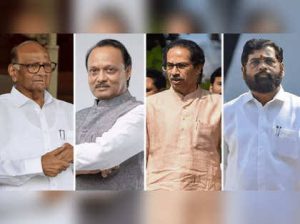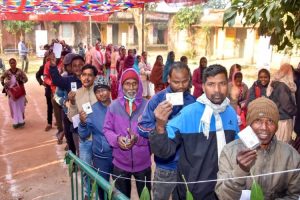Digital News Guru Election Desk:
Overview
November 20, 2024, marked a significant day in Indian politics as Maharashtra held its single-phase Assembly election, while Jharkhand concluded its second phase of polling. Both states saw a mix of vibrant democratic participation and regional political dynamics at play. The results for these elections are scheduled for November 23.
Maharashtra: Urban-Rural Divide in Turnout
Maharashtra, with its 288 assembly constituencies, recorded voter turnout figures that revealed stark contrasts. By 3 PM, 45.53% of eligible voters had cast their ballots, reflecting moderate participation. The tribal-dominated district of Gadchiroli stood out with a high turnout of 62.99%, while urban areas like Mumbai City lagged behind at 27.73%. These disparities highlight a persistent challenge in mobilizing urban voters.

Key constituencies to watch include Mumbai’s Worli and Malabar Hill, Pune’s Kothrud, and Nagpur South-West, where major political heavyweights are contesting. The elections are primarily seen as a battleground between the Maha Vikas Aghadi (MVA) coalition, led by the Shiv Sena (UBT), Congress, and NCP, and the Bharatiya Janata Party (BJP)-led National Democratic Alliance (NDA). Issues such as inflation, infrastructure, and agrarian distress have dominated campaigns.
Jharkhand: Rural Engagement Drives Participation
In Jharkhand, the second phase of voting covered 38 constituencies, concluding a two-phase election process. The state reported a robust voter turnout of 61.47% as of late afternoon. Notable districts like Ranchi (65.84%) and Pakur (69.31%) demonstrated high levels of engagement. In contrast, urban areas like Bokaro showed lower participation at 56.38%.
The ruling Jharkhand Mukti Morcha (JMM), in alliance with Congress, is facing a tough challenge from the BJP. The elections here are crucial for the BJP to make inroads, while the JMM seeks to consolidate its tribal vote base. Environmental issues, mining rights, and tribal autonomy have been focal points in this election.

Common Trends and Broader Implications
The Assembly elections in Maharashtra and Jharkhand are pivotal for both state and national politics, setting the tone for the 2024 General Elections. For the BJP, retaining power in Maharashtra and expanding its influence in Jharkhand are critical goals. Conversely, opposition alliances like the MVA in Maharashtra and the JMM-Congress coalition in Jharkhand aim to leverage local grievances and anti-incumbency sentiments to solidify their positions.
Key issues across both states include unemployment, infrastructure development, and governance transparency. Additionally, voter turnout patterns—particularly the gap between urban and rural participation—remain a recurring theme that both political analysts and parties will scrutinize.
Stay tuned for the election results on November 23, which will shed light on the future political landscape of these regions.
You May Also Read: Maharashtra Elections 2024: All 288 Assembly Seats Up for Grabs on November 20








